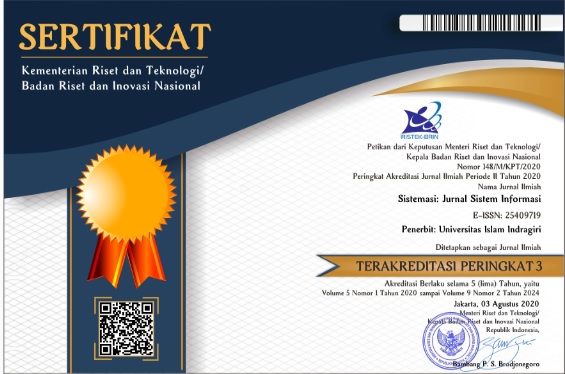Sentiment Analysis of Cyberbullying Detection on Social Networks using the Sentistrenght Method
Abstract
Full Text:
PDFReferences
T. Akhir and S. Komputer, “Fakultas Ilmu Komputer dan Rekayasa Universitas Multi Data Palembang”.
H. A. Dewi, S. Suryani, and A. Sriati, “Faktor faktor yang memengaruhi cyberbullying pada remaja: A Systematic review,” J. Nurs. Care, vol. 3, no. 2, Jun. 2020.
A. M. A Putri, “View of Analisis Sentimen Cyberbullying KPOP di Media Sosial Twitter Menggunakan Metode Naive Bayes,” J. Syntax Lit., vol. 7, no. 9, 2022, Accessed: May 26, 2023.
Machsun Rifauddin, “FENOMENA CYBERBULLYING PADA REMAJA (Studi Analisis Media Sosial Facebook),” KHIZANAH AL-HIKMAH, vol. 4, pp. 35–44, 2016.
V. W. NF Hasan, “View of Deteksi Cyberbullying pada Facebook Menggunakan Algoritma K-Nearest Neighbor,” J. Smart Syst., p. 10, 2021.
T. S. RW Hardian, PE Prasetyo, U Khaira, “View of Analisis Sentiment Kuliah Daring Di Media Sosial Twitter Selama Pandemi Covid-19 Menggunakan Algoritma Sentistrength,” MALCOM.,vol. 1, no.5, 2021.
M. F. Rizki, K. Auliasari, and R. P. Prasetya, “ANALISIS SENTIMENT CYBERBULLYING PADA SOSIAL MEDIA TWITTER MENGGUNAKAN METODE SUPPORT VECTOR MACHINE,” JATI (Jurnal Mhs. Tek. Inform., vol. 5, no. 2, pp. 548–556, 2021.
T. T. SS Sari, UK Ulfa, PEPU Pradita, “View of Analisis Sentimen Terhadap Komentar Beauty Shaming Di Media Sosial Twitter Menggunakan Algoritma SentiStrength,” IJIRSE., vol. 1, no.3, p. 8, 2021.
Indriana Hidayah, Adhistya Erna Permanasari, and Theopilus Bayu Sasongko, Proceedings of Conference on Information Technology and Electrical Engineering. 2014.
M. Stephenson, "Northumbria Research Link (www.northumbria.ac.uk/nrl)," Acad. Manag., vol. 51, no. September, pp. 1–51, 2021.
M. Thelwall, "The Heart and Soul of the Web? Sentiment Strength Detection in the Social Web with SentiStrength," Underst. Complex Syst., vol. 5, pp. 119–134, 2017, doi: 10.1007/978-3-319-43639-5_7.
S. S. Milania, C. Suhery, and T. Rismawan, "Fever Classification Using the Neighbor Weighted K-Nearest Neighbor Method," CESS (Journal Comput. Eng. Syst. Sci., vol. 8, no. 2, pp. 250–261, Jul. 2023, doi: 10.24114/CESS.V8I2.43267.
O. Fanny and H. Suroyo, "SISTEMASI: Jurnal Sistem Informasi Analisis Sentimen Pengguna Media Sosial Terhadap Omnibus Law Berdasarkan Hashtag di Twitter Analysis of Social Media Users Sentiments against Omnibus Law Based on Hashtags on Twitter," Januari, vol. 11, no. 1, pp. 197–206, 2022.
E. Miranda, V. Gabriella, S. A. Wahyudi, and J. Chai, “Text Classification untuk Menganalisis Sentimen Pendapat Masyarakat Indonesia terhadap Vaksinasi Covid - 19 Text Classification for Analysing Indonesian People ’ s Opinion Sentiment for,” J. Sist. Inf., vol. 12, pp. 438–451, 2023.
M. Naufal, B. Balit, F. S. Utomo, I. S. Program, and C. Java, “Sentiment Analysis of pegipegi . com Review on Google Play Store with Naïve Bayes,” vol. 13, pp. 1044–1053, 2024.
P. D. Turney, "Mining the Web for Lexical Knowledge to Improve Keyphrase Extraction: Learning from Labeled and Unlabeled Data," 2002.
M. Kitsuregawa et al., "Modern information retrieval: A brief overview," vol. 24, no. 4, 2003.
L. Havrlant and V. Kreinovich, "A Simple Probabilistic Explanation of Term Frequency-Inverse A Simple Probabilistic Explanation of Term Frequency-Inverse Document Frequency (TF-IDF) Heuristic (and Variations Motivated Document Frequency (TF-IDF) Heuristic (and Variations Motivated by Th," 2014.
N. Hardi, Y. Alkahfi, P. Handayani, W. Gata, and M. R. Firdaus, “Analisis Sentimen Physical Distancing pada Twitter Menggunakan Text Mining dengan Algoritma Naive Bayes Classifier,” Sistemasi, vol. 10, no. 1, p. 131, 2021, doi: 10.32520/stmsi.v10i1.1118.
DOI: https://doi.org/10.32520/stmsi.v13i4.4226
Article Metrics
Abstract view : 582 timesPDF - 227 times
Refbacks
- There are currently no refbacks.

This work is licensed under a Creative Commons Attribution-ShareAlike 4.0 International License.









